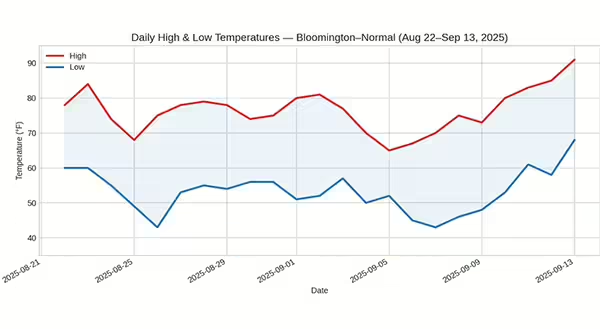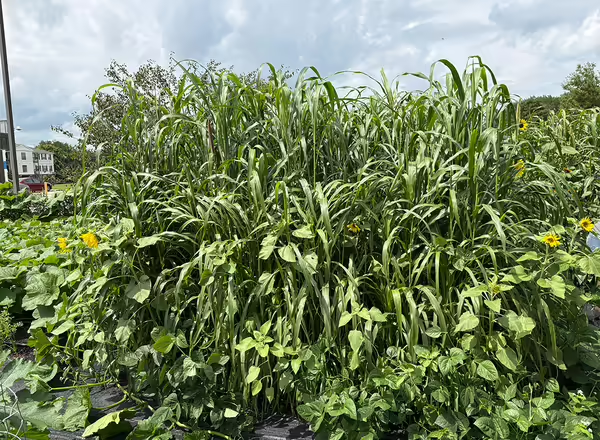
Weather and precipitation summary for Bloomington-Normal
Here in central Illinois over the last 30 days, the hottest temperature observed was 91°F on September 13th, while the coolest temperature observed was 43°F on August 26th.
Many mornings and evenings were in the upper 40s to low 50s from August 26th to September 10th. Significant precipitation occurred on September 3rd, with nearly 1 inch of rain in Bloomington, while most other days were dry or saw only trace amounts. Overall, temperatures ranged from the mid-40s to low 90s, with many cool nights in late August and early September.
While it may not seem like it in the last week due to hot and dry temperatures, this period was slightly cooler than normal, compared to historical averages.
Unity Community Center Food Production and Demonstration Site Update
Ginger Rhizome Production, Fertigation 101, and Summer Cover Crops Workshops a Success
On August 19th, we hosted 20 people in two groups of 10 for one morning and one evening session of the same workshop. With our three topics covered, there was something new and interesting on offer for everybody.
This is our first year in our new garden site – very near to the old site, but sadly our new site up until late fall 2024 was full of thistle-type weeds. Therefore, we had to spend quite a bit of energy, time, staff hours etc. rejuvenating the soil on 50-ish% of the site while smothering aggressive perennial weeds. We accomplished that with our Sudangrass, pearl millet, sunflower, buckwheat, cowpea, and Balansa clover 6-way cover crop mix – which was on full display for August 19th workshops.
Ginger rhizome is a promising specialty crop for Illinois growers. However, more research is needed to identify best practices of production. This year at our site, ginger rhizome was grown in soilless media grow bags placed on 3-ft high pallets, in collaboration with the Illinois Ginger Growers Grant group across the state. Attendees of this workshop were able to see ginger rhizome in grow bags with three different levels of fertility – low, medium, and high.
The high-fertility ginger grow bags have been hooked up to a Nolt’s Midwest Produce Supply custom-built fertigation cart, with a MiniDos 12 ¾” MPT fertigation injector. The ginger has received at least one fertigation application of Cal-Mag Special 17-5-17 per week since mid-June.
Both workshop sessions’ participants had engaging conversations with presenters and each other about all things summer cover crops, ginger, and fertigation.
Summer Cover Crop Crimped – Without Roller-Crimper
On August 22nd, 3 days after our workshop, our team got to work crimping our 8-9-ft-tall, 6-way cover crop mix – with a T-post. It took 20 minutes to terminate this way and would have taken much shorter if we had ever done this before.
Two of us strapped a 7-ft-long T-post to our boots, and in synchronized steps, “crimped” the cover crop wherever it was planted. We encountered praying mantis, wheel bug, grasshoppers, caterpillars, butterflies, and other critters as we worked. There is now 3-5 inches of thick biomass laying down over the top of what was 12 months ago a weed thicket. We are very hopeful for a productive, near-thistle-free growing season at the Unity production site next year.
The T-post did a great job of breaking the stem of all the cover crops. In particular, the Sudangrass and pearl millet broke mostly cleanly at the base and were all at various stages of flowering or grain formation at the time of termination – i.e. we terminated at the correct time for crimping to work. I would recommend Sudangrass and pearl millet as an excellent grass-based smothering summer cover crop for production areas suffering from perennial weeds in particular – likely in combination with other forms of control, such as occultation tarps, and deep compost applications.
There are some spots that have popped back up and are still green, and re-growing a bit, here and there. However, we will let it go, because none of this cover crop is winter hardy. It will all die from the first hard frost, at which point we plan to silage tarp everything to assist with the biomass breakdown, such that we can transplant directly into the residue in early-mid May.

